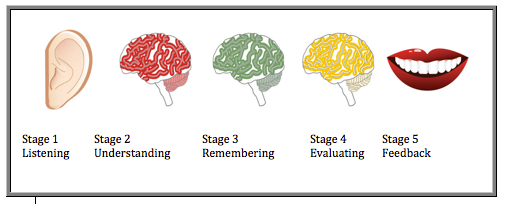
To listen is to give attention to sound or action. When listening, one is hearing what others are saying, and trying to understand what it means. The act of listening involves complex affective, cognitive, and behavioral processes. Affective processes include the motivation to listen to others; cognitive processes include attending to, understanding, receiving, and interpreting content and relational messages; and behavioral processes include responding to others with verbal and nonverbal feedback.
Listening can be a useful skill for different problems, but it is essential to solve conflict, poor listening can lead to misinterpretations thus causing conflict or a dispute. Other causes can be excessive interruptions, inattention, hearing what you want to hear, mentally composing a response, and having a closed mind. In this article we will look at the difference and similarities between listening and hearing according to MCC .
Difference Between Hearing And Listening
Hearing vs. Listening
- Do you think there is a difference between hearing and listening?
- You are right, there is!
- Hearing is simply the act of perceiving sound by the ear. If you are not hearing-impaired, hearing simply happens.
- Listening, however, is something you consciously choose to do. Listening requires concentration so that your brain processes meaning from words and sentences. Listening leads to learning.
Most people tend to be “hard of listening” rather than “hard of hearing.”
Listening
. . . is intermittent.
. . . is a learned skill.
. . . is active.
. . . implies using the message received.
The Process of Listening
Obstacles to Effective Listening
- Physical distractions
- Physiological distractions
- Psychological distractions
- Factual distractions
- Semantic distractions
Promoting Better Listening
- Desire to listen.
- Focus on the message.
- Listen for main ideas.
- Understand the speaker’s point of view
- Withhold judgment.
- Reinforce the message.
- Provide feedback.
- Listen with the body.
- Listen critically.
Types of Listening
- Active vs. Passive
- Positive vs. Negative
- What Kind is it?
- Appreciative
- Empathic
- Discriminative
- Analytical
Importance of Listening
Most frequently used communication skill
- 50% of typical workday spent communicating
- of this 50%, 45% is spent listening
- 45% of business person’s salary earned listening
Good listeners
- are perceived as more intelligent
- save time, energy, and other resources
- increase chances for advancement and success
What is Interactive Listening?
- Cultivated Skill involving the goal-oriented active, positive process of receiving and attending to aural stimuli
- Conscious elimination of perceptual barriers
How Important is Interactive Listening?
- Critical for occupational advancement
- Leads to perception of intelligence
- Saves time, money, and resources
How to Improving Your Listening Skills
- Identify Objectives
- Know Your Listening Habits
- Generate Motivation and Energy
- Eliminate Distractions
- Ask questions
- Closed
- Open
- Probing
- Evaluate Your Progress
Effective Listening
- Effective listening requires an understanding that it is not just the speaker’s responsibility to make sure he/she is understood.
- The listener has a major role to play in hearing the complete message.
- The following ideas will assist the listener in understanding the message.
Ten Commandments of Effective Listening
- Stop talking! You cannot listen when you are talking. You will only be thinking about what you are going to say next instead of paying attention to what the other person is trying to say. Consciously focus your attention on the speaker.
- Put the speaker at ease: Relax, smile, look at the speaker and help that person feel free to talk. Look and act interested. Remove distractions: turn off the TV; close the door; stop what you are doing, and pay attention.
- Pay attention to the nonverbal language of physical gestures, facial expressions, tone of voice, and body posture. An authority on nonverbal language says that 55 percent of the message meaning is nonverbal, 38 percent is indicated by tone of voice, and only 7 percent is conveyed by the words used in a spoken message. Few people know how to listen to the eyes; what a tapping foot means; a furrowed brow; clenched fist; the biting of nails. These often reveal the key feelings behind the words.
- Listen for what is not said. Ask questions to clarify the meaning of words and the feelings involved, or ask the speaker to enlarge on the statement. People often find it difficult to speak up about matters or experiences that are very important or highly emotional for them. Listen for how the speaker presents the message. What people hesitate to say is often the most critical point.
- Know exactly what the other person is saying. Reflect back what the other person has said in a “shared meaning” experience so you completely understand the meaning and content of the message before you reply to it. A good listener does not assume they understand the other person. You, as the listener, should not express your views until you have summarized the speaker’s message to his satisfaction.
- Stop talking! You cannot listen when you are talking. You will only be thinking about what you are going to say next instead of paying attention to what the other person is trying to say. Consciously focus your attention on the speaker.
- Put the speaker at ease: Relax, smile, look at the speaker and help that person feel free to talk. Look and act interested. Remove distractions: turn off the TV; close the door; stop what you are doing, and pay attention.
- Pay attention to the nonverbal language of physical gestures, facial expressions, tone of voice, and body posture. An authority on nonverbal language says that 55 percent of the message meaning is nonverbal, 38 percent is indicated by tone of voice, and only 7 percent is conveyed by the words used in a spoken message. Few people know how to listen to the eyes; what a tapping foot means; a furrowed brow; clenched fist; the biting of nails. These often reveal the key feelings behind the words.
- Listen for what is not said. Ask questions to clarify the meaning of words and the feelings involved, or ask the speaker to enlarge on the statement. People often find it difficult to speak up about matters or experiences that are very important or highly emotional for them. Listen for how the speaker presents the message. What people hesitate to say is often the most critical point.
- Know exactly what the other person is saying. Reflect back what the other person has said in a “shared meaning” experience so you completely understand the meaning and content of the message before you reply to it. A good listener does not assume they understand the other person. You, as the listener, should not express your views until you have summarized the speaker’s message to his satisfaction.
- Hold your temper! Try to keep your own emotions from interfering with your listening efficiency. When emotions are high, there is a tendency to tune out the speaker, become defensive, or want to give advice. You don’t have to agree to be a good listener. Don’t argue! Even if you win, you lose.
- Empathize with the speaker. Try to “walk in the other’s moccasins” so you can feel what that person is feeling and understand the point of view the speaker is trying to convey.
Conclusion
- “What is so important about listening? I listen!”
- Sure you do. But how? How adept are you, for example, in getting people to come right out and really talk to you?
- Before you can get the most out of a listening situation, others must first believe that you really want to listen. They must feel that when they tell you something, it will be received by you in the proper spirit.
- Learn to listen beyond the words, with your heart as well as your ears.
- Observe the signs of the inner feelings such as voice quality, facial expressions, body posture and motions, etc. These actions are revealing, and sometimes may have an opposite meaning from the spoken word.
- A friend put it this way: “You listened as if you wanted to hear what I was going to say, as if it was really important to you. And that makes me feel good!”
SEE: How To Dispose Of Hearing Aid Batteries






